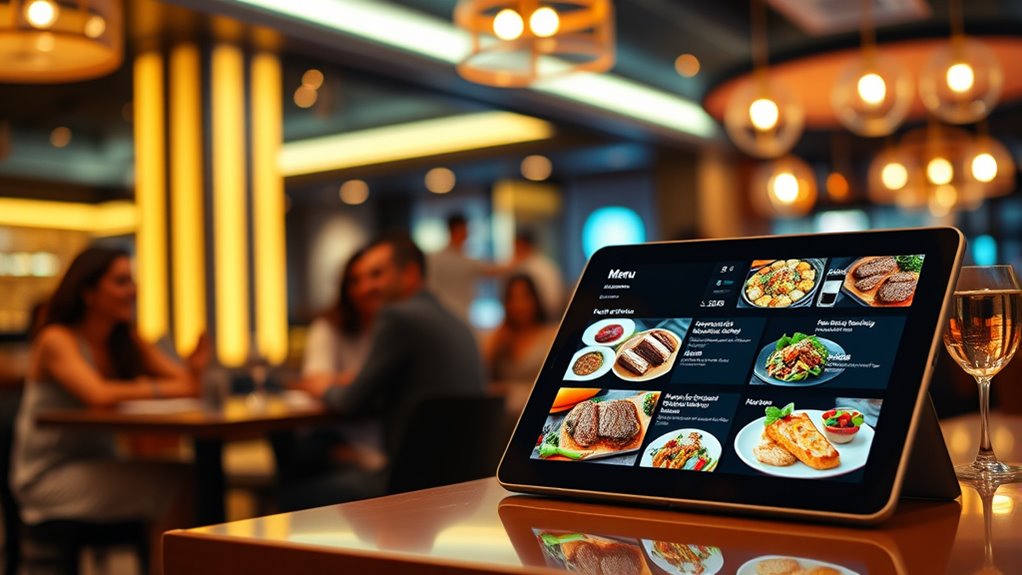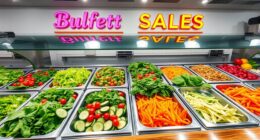AI-powered menu personalization is rapidly gaining momentum in restaurants, helping you deliver tailored dining experiences. It streamlines operations, recommends dishes based on individual preferences, and improves customer satisfaction. By analyzing data from orders, feedback, and online activity, AI creates real-time suggestions that boost sales and loyalty. Although challenges like data privacy and system integration exist, exploring this trend can transform your restaurant’s service. Keep going to discover how these innovations can work for you.
Key Takeaways
- AI enables real-time menu customization based on customer preferences, dietary needs, and browsing behavior.
- Restaurants leverage data analytics to identify trending flavors and optimize menu offerings.
- Personalization improves customer satisfaction and loyalty, driving increased sales and repeat visits.
- Integration challenges and data privacy concerns are being addressed to ensure seamless, secure AI-driven experiences.
- Future advancements include immersive technologies like AR and voice recognition, enhancing interactive menu personalization.
The Rise of AI in the Restaurant Industry
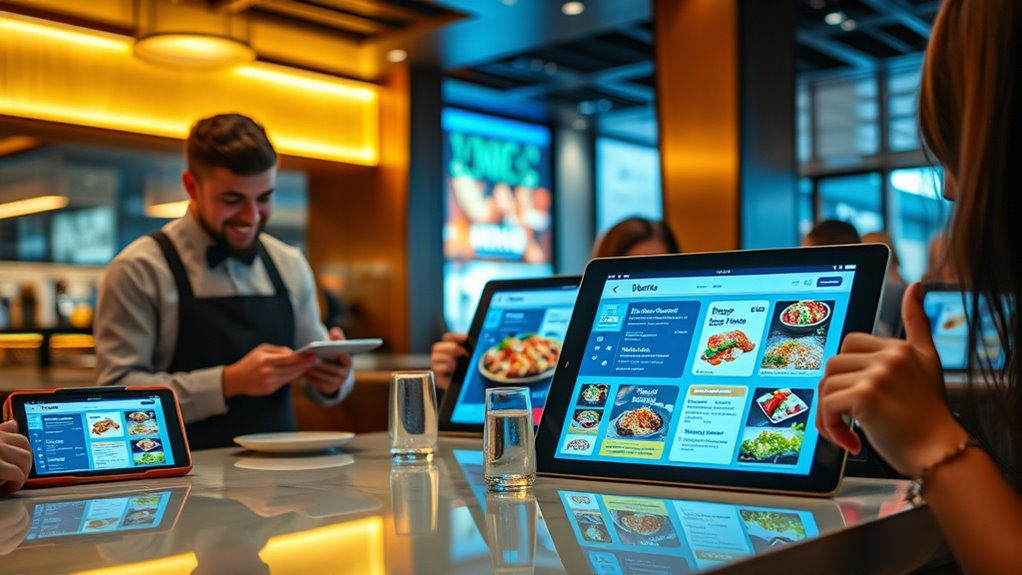
The restaurant industry is experiencing a significant transformation as AI technology becomes more prevalent. You’ll notice how restaurants are adopting AI-driven tools to streamline operations, from automating order processing to managing inventory. AI helps chefs optimize recipes, ensuring consistency and quality, while staff benefit from intelligent scheduling systems that match staffing levels with customer demand. Customer service is also improving, as AI chatbots handle inquiries and reservations efficiently. With data analytics, restaurants gain insights into customer preferences and trends, allowing them to adapt quickly. This surge in AI adoption isn’t just a trend; it’s reshaping how restaurants operate daily. As AI continues to evolve, you’ll see even more innovative solutions that enhance efficiency, reduce costs, and improve overall customer satisfaction. Incorporating cultural intelligence into these technological advancements can further support diverse customer needs and preferences.
How Personalization Enhances Customer Experience

As AI-driven tools become more integrated into restaurant operations, personalized experiences for customers are taking center stage. When your menu adapts to your preferences, dining becomes more enjoyable and efficient. You’re more likely to find dishes that match your taste, dietary needs, or past favorites, making each visit feel tailored just for you. This personalization reduces decision fatigue and builds a sense of connection with the restaurant. When staff can anticipate your preferences, service feels more attentive and genuine. Overall, AI-powered personalization creates a smoother, more satisfying experience that encourages you to return. It transforms a simple meal into a memorable event, fostering loyalty and making you feel valued every time you dine. Additionally, advancements in automation technology are enabling restaurants to deliver these personalized services more effectively and at scale.
Data Collection and Analysis for Menu Customization
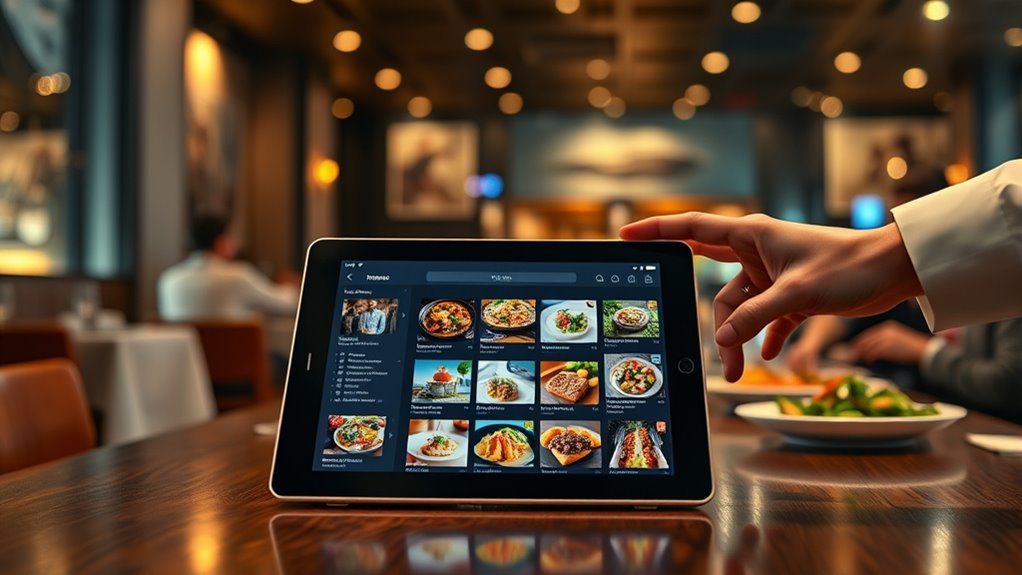
To customize menus effectively, you rely on collecting and analyzing data from various sources such as order histories, customer feedback, and online interactions. Order data reveals your customers’ preferences and repeat choices, helping you identify popular items and gaps. Customer feedback, whether through surveys or reviews, provides insights into their satisfaction and dislikes. Online interactions, including website visits and social media activity, show emerging trends and interests. You analyze this data to detect patterns and preferences that inform your menu updates. Accurate data collection guarantees your insights are reliable, enabling you to tailor offerings that resonate with your audience. This process forms the foundation for effective AI-driven personalization, making your menu more appealing and customer-centric.
Algorithms Driving Menu Recommendations
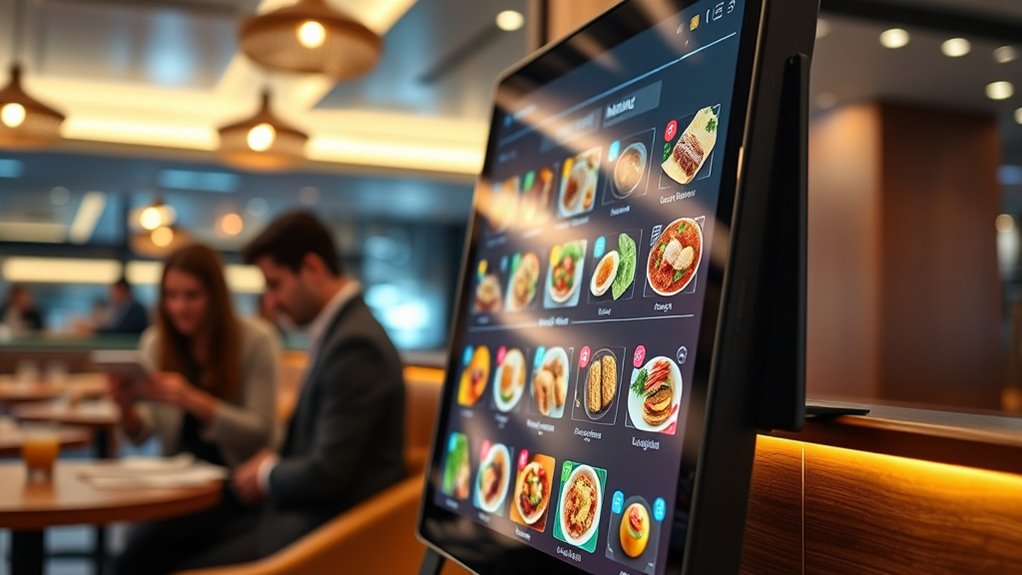
Algorithms analyze real-time data to understand your preferences instantly. They adapt menus on the fly to create a more personalized dining experience. This dynamic approach guarantees you get recommendations that match your tastes every time you visit. Incorporating mindful choices in menu recommendations can also promote healthier and more sustainable eating habits.
Real-Time Data Analysis
Real-time data analysis is the engine behind personalized menu recommendations, enabling systems to adapt instantly to customer preferences. As you serve customers, algorithms process live data—such as order history, browsing behavior, and feedback—to refine suggestions on the spot. This continuous analysis helps you present relevant options, boosting satisfaction and sales. Incorporating dynamic refresh rates further enhances the system’s responsiveness, ensuring recommendations stay current and accurate.
Personalized Dining Experiences
By analyzing customer data, algorithms craft highly personalized dining experiences that feel tailored to your individual preferences. They consider your past orders, dietary restrictions, and even your favorite flavors to suggest dishes you’ll love. This hyper-personalization helps you discover new options while ensuring every recommendation aligns with your tastes. Restaurants benefit too, as this targeted approach increases satisfaction and loyalty. With AI-driven menu recommendations, you spend less time deciding and more time enjoying your meal. Ultimately, this technology transforms dining into a customized journey, where each visit feels uniquely suited to your palate and needs. Incorporating farmhouse kitchen textiles and vintage-inspired decor can enhance the overall dining atmosphere, making each experience even more memorable.
Benefits of AI-Powered Personalization for Restaurants
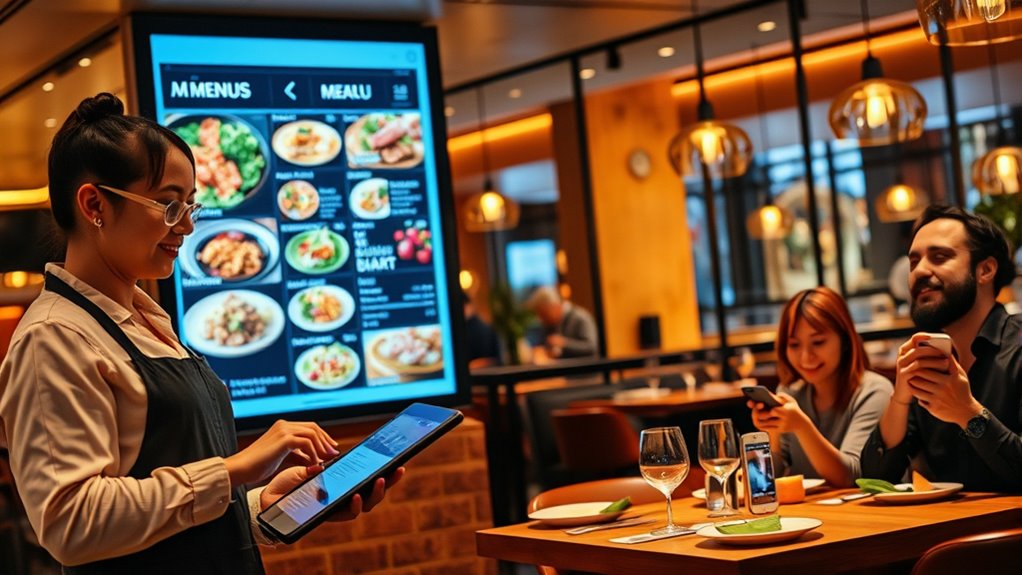
Implementing AI-powered personalization can markedly enhance your restaurant’s ability to cater to individual customer preferences, leading to increased satisfaction and loyalty. By leveraging AI, you can offer tailored menu recommendations that align with each guest’s tastes, dietary needs, and past orders. This personalization boosts the dining experience, encouraging repeat visits. Additionally, AI helps optimize your menu by identifying popular items and trending flavors, allowing you to adapt quickly. It also reduces wait times through efficient order processing and suggests complementary dishes to upsell naturally. Furthermore, AI-driven insights enable better inventory management, minimizing waste and controlling costs. Recognizing the importance of active listening and empathy in understanding customer needs can significantly improve service quality. Overall, embracing AI personalization creates a more engaging, efficient, and profitable restaurant environment that keeps customers coming back.
Challenges and Considerations in Implementation

Implementing AI-powered menu personalization involves steering through several hurdles that can impact your success. You need to address data privacy concerns to protect customer information and comply with regulations. Additionally, integrating new systems can be complex, and ensuring the recommendations are accurate is essential to maintain customer trust. Incorporating ongoing personal growth strategies, such as staying informed about best practices, can help adapt to these challenges effectively.
Data Privacy Concerns
Have you ever wondered how AI-powered menu personalization can raise privacy concerns? As you adopt these technologies, you’re collecting vast amounts of customer data, which can lead to sensitive information exposure. You need to be mindful of:
- Data collection without explicit consent
- Potential data breaches compromising customer info
- Usage of personal data beyond intended purposes
- Compliance with regulations like GDPR or CCPA
- Maintaining transparency about data handling practices
Ignoring these issues risks legal penalties and damaging your reputation. Customers are increasingly aware of their privacy rights and demand trustworthiness. To address these concerns, implement clear data policies, secure storage, and transparent communication. Balancing personalization benefits with privacy safeguards is essential for sustainable success.
Integration Complexities
While addressing privacy concerns is essential, integrating AI-powered menu personalization systems into your existing infrastructure presents its own set of challenges. Compatibility issues can arise when new AI tools don’t seamlessly connect with your current POS or inventory systems. Data silos may hinder real-time updates, leading to delays in personalized recommendations. Additionally, implementing AI requires technical expertise, which might mean hiring specialists or training staff. You also need to consider the costs involved—not just for technology but for ongoing maintenance and updates. Here’s a quick overview:
| Challenge | Consideration |
|---|---|
| Compatibility | Ensuring system integration |
| Data Silos | Facilitating real-time data flow |
| Technical Expertise | Hiring or training staff |
| Cost | Budgeting for implementation |
| Maintenance & Updates | Planning for ongoing support |
Furthermore, understanding the technical requirements for AI integration can help you better plan your resources and timelines.
Accuracy of Recommendations
Ensuring that AI-powered menu recommendations are accurate is a key challenge in their successful deployment. If the system suggests irrelevant options, customers may feel frustrated, and sales could decline. You need to contemplate several factors to improve accuracy:
- Data quality: Incomplete or outdated data can skew recommendations.
- User profiles: Inaccurate profiles lead to mismatched suggestions.
- Algorithm tuning: Poorly calibrated models misinterpret preferences.
- Context awareness: Ignoring factors like time or location reduces relevance.
- Feedback loops: Without continuous learning, recommendations become stale.
- Proper storage of data, such as keeping information in cool, dark places, can help maintain its integrity and improve recommendation reliability.
Balancing these elements is essential to create precise, personalized suggestions that enhance customer experience and drive sales. Regular updates, robust data management, and iterative improvements are crucial for maintaining recommendation accuracy over time.
Case Studies of Successful AI-Driven Menus

Several restaurants have seen remarkable results by implementing AI-driven menus that adapt to customer preferences in real time. For example, a high-end steakhouse used AI to analyze diners’ ordering patterns, enabling them to personalize suggestions, resulting in a 20% increase in average check size. Similarly, a fast-casual chain integrated AI into their ordering system, which tailored menu options based on individual tastes and dietary restrictions. This led to improved customer satisfaction and repeat visits. Another case involved a hotel restaurant that employed AI to recommend dishes based on guest profiles, increasing upselling success. These examples demonstrate how AI-powered menus can boost sales, enhance customer experience, and foster loyalty by delivering relevant, personalized options that resonate with each diner’s preferences. Additionally, real-time updates to digital menus benefit from hours today list information, ensuring menus are accurate and accessible during busy periods.
Future Trends in Menu Personalization Technology

Building on the success stories of AI-driven menus, the future of menu personalization technology promises even more sophisticated and seamless experiences. You can expect advancements that enable real-time customization based on customer preferences, dietary needs, and even mood. AI will increasingly leverage data from social media, wearables, and purchase history to anticipate your desires. Enhanced voice recognition and visual analysis will allow hands-free, intuitive interactions. Additionally, machine learning will refine recommendations, making them more accurate over time. The integration of augmented reality may let you see virtual menu previews before ordering. Finally, personalized menus will become more dynamic, adjusting throughout your dining experience to ensure satisfaction at every step. These trends will transform how you engage with restaurant menus, creating more meaningful dining encounters.
Frequently Asked Questions
How Does AI Ensure Customer Privacy During Data Collection?
You might wonder how AI keeps your privacy safe during data collection. AI uses encryption to protect your information and anonymizes data to prevent personal identification. It follows strict privacy policies and regulatory standards like GDPR. Additionally, AI collects only necessary data, minimizing risks. By implementing these measures, AI guarantees your personal details stay secure while still providing personalized experiences, giving you peace of mind every time your data is used.
What Are the Costs Associated With Implementing Ai-Powered Menus?
Implementing AI-powered menus involves costs like purchasing or developing software, integrating it with existing systems, and ongoing maintenance. You’ll also need to train staff and manage data security measures. These expenses can vary depending on your restaurant’s size and complexity. While initial investment might seem high, the benefits—like improved customer experience and increased sales—often outweigh the costs over time, making it a worthwhile upgrade.
How Do Staff Adapt to New Ai-Driven Systems?
You might feel overwhelmed at first, but staff quickly adapt to AI-driven systems by embracing the change. Training sessions become exciting adventures, transforming fear into confidence. As you master these tools, you’ll see your team become super-efficient, making tasks feel almost effortless. With patience and practice, staff will not only adapt but thrive, turning what seems like a formidable challenge into an exciting journey of growth and innovation.
Can Small Restaurants Afford AI Menu Personalization?
You might wonder if small restaurants can afford AI menu personalization. While initial costs can seem high, many affordable options now exist that fit smaller budgets. Cloud-based solutions and scalable platforms let you start small and expand as you see results. By investing in AI, you can attract more customers and enhance their experience without breaking the bank. With careful planning, AI personalization becomes a feasible and valuable tool for your business.
What Are Potential Biases in AI Algorithms for Menu Recommendations?
Imagine AI algorithms as a busy chef, mixing ingredients to serve personalized menus. But biases can sneak in like a dash of salt, skewing recommendations based on flawed data or stereotypes. These biases might favor certain cuisines, overlook dietary needs, or reinforce stereotypes, leading to unfair suggestions. You must stay vigilant, ensuring the algorithm’s recipe remains balanced, fair, and inclusive, so every customer feels truly valued and understood.
Conclusion
As AI transforms restaurant menus into personalized journeys, you’re steering your guests toward unforgettable experiences. Think of AI as a skilled guide, maneuvering the vast landscape of customer preferences to craft a menu that feels tailored just for each diner. Embracing this technology isn’t just a trend—it’s your compass to stand out in a competitive industry. By harnessing AI, you’re planting seeds for loyalty and growth, turning every meal into a memorable story your guests will want to revisit.
